Curtain University R&S Report: Key Contextual Factors Analysis
VerifiedAdded on 2022/08/25
|12
|3278
|45
Report
AI Summary
This report provides a comprehensive analysis of the key contextual factors influencing recruitment and selection (R&S) processes within the field of Human Resource Management (HRM). The report explores the impact of social media, technological innovation, and the trend towards outsourcing on R&S practices. It examines the context of each factor, detailing its specific effects on recruitment strategies, candidate selection, and overall organizational effectiveness. The analysis includes a discussion of the challenges associated with each factor, such as the ethical considerations of social media usage, the complexities of integrating new technologies, and the risks involved in outsourcing. The report offers recommendations for HR practitioners to navigate these challenges and leverage the opportunities presented by these evolving trends. Finally, it highlights the importance of adapting R&S strategies to remain competitive in the modern job market. The report concludes by emphasizing the need for strategic HRM approaches to ensure organizational success in a dynamic environment.
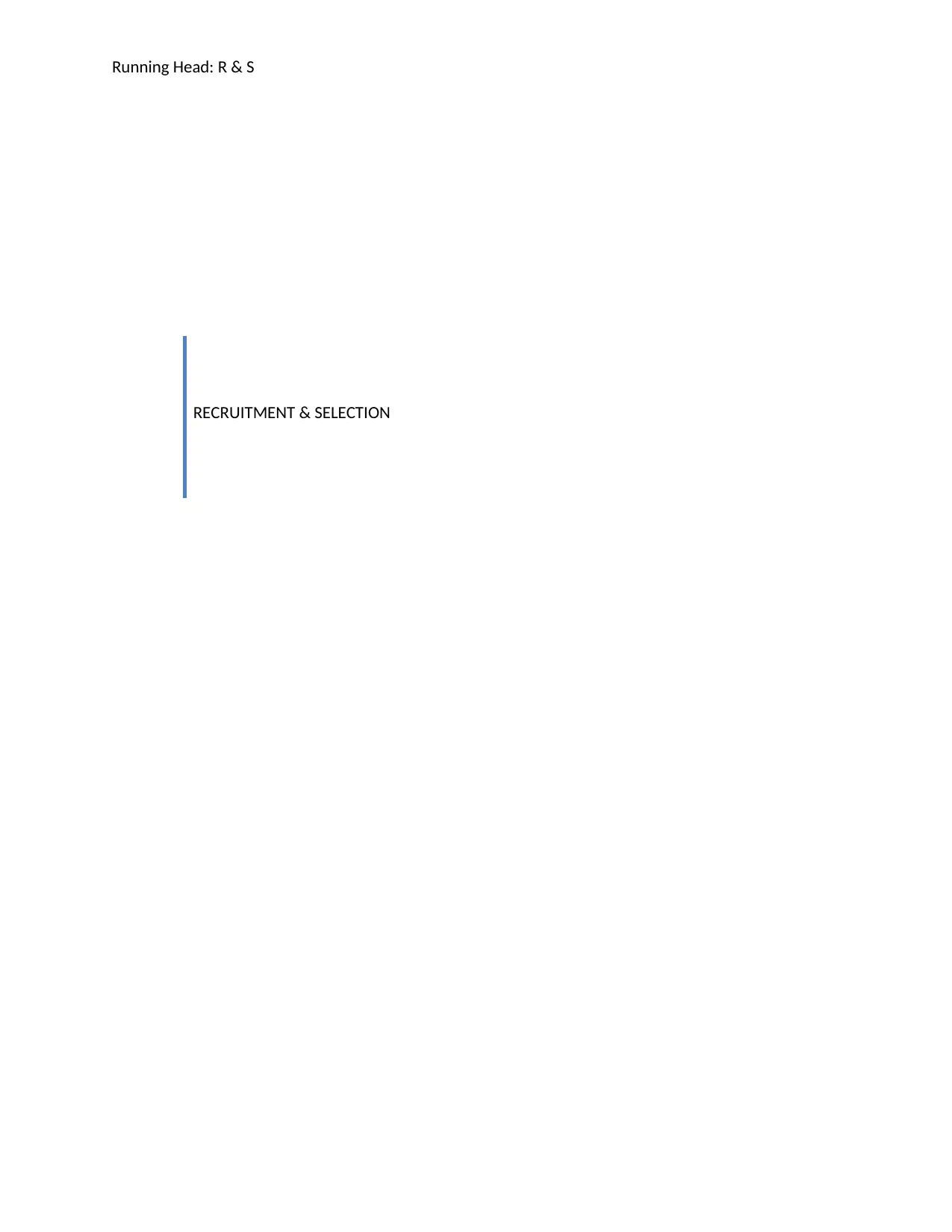
Running Head: R & S
RECRUITMENT & SELECTION
RECRUITMENT & SELECTION
Secure Best Marks with AI Grader
Need help grading? Try our AI Grader for instant feedback on your assignments.
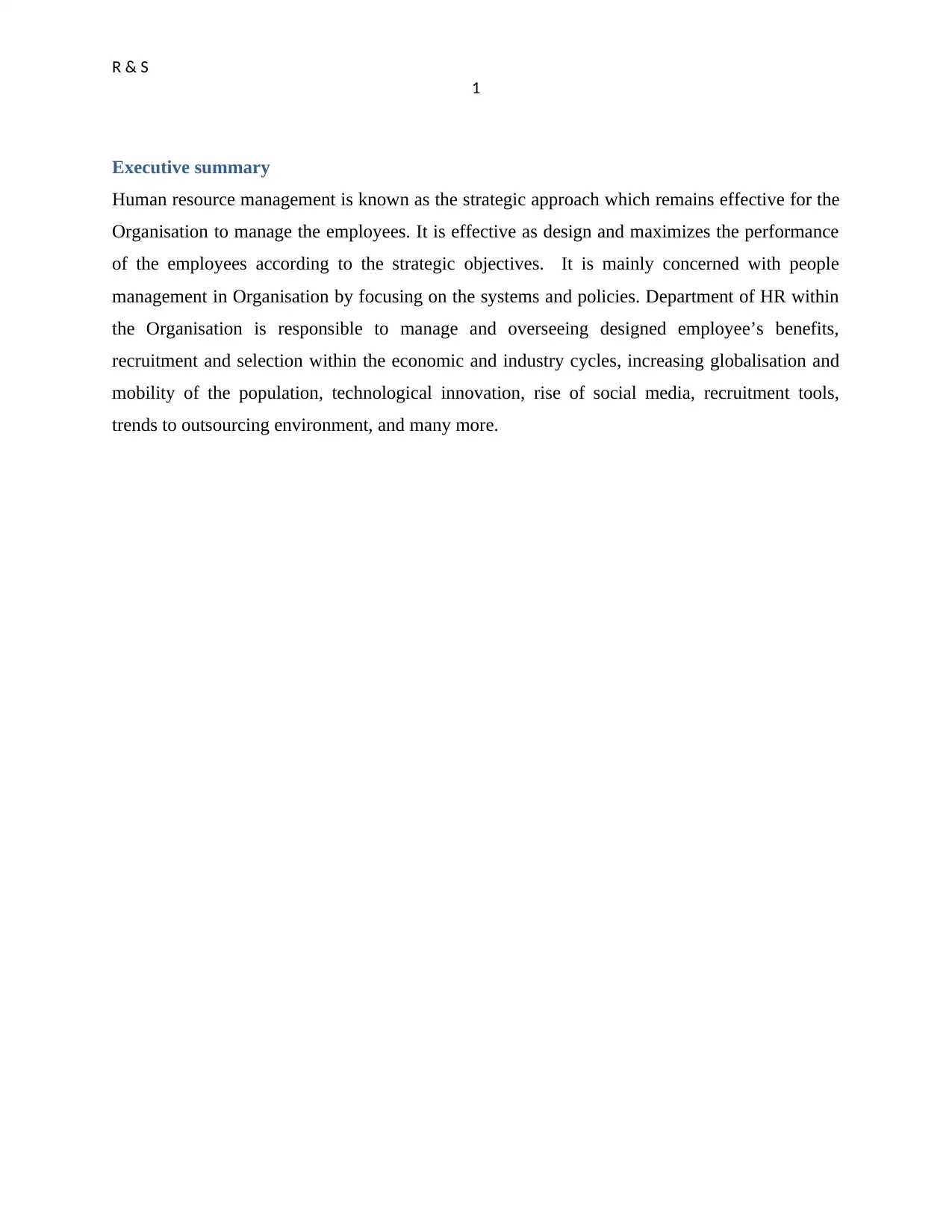
R & S
1
Executive summary
Human resource management is known as the strategic approach which remains effective for the
Organisation to manage the employees. It is effective as design and maximizes the performance
of the employees according to the strategic objectives. It is mainly concerned with people
management in Organisation by focusing on the systems and policies. Department of HR within
the Organisation is responsible to manage and overseeing designed employee’s benefits,
recruitment and selection within the economic and industry cycles, increasing globalisation and
mobility of the population, technological innovation, rise of social media, recruitment tools,
trends to outsourcing environment, and many more.
1
Executive summary
Human resource management is known as the strategic approach which remains effective for the
Organisation to manage the employees. It is effective as design and maximizes the performance
of the employees according to the strategic objectives. It is mainly concerned with people
management in Organisation by focusing on the systems and policies. Department of HR within
the Organisation is responsible to manage and overseeing designed employee’s benefits,
recruitment and selection within the economic and industry cycles, increasing globalisation and
mobility of the population, technological innovation, rise of social media, recruitment tools,
trends to outsourcing environment, and many more.
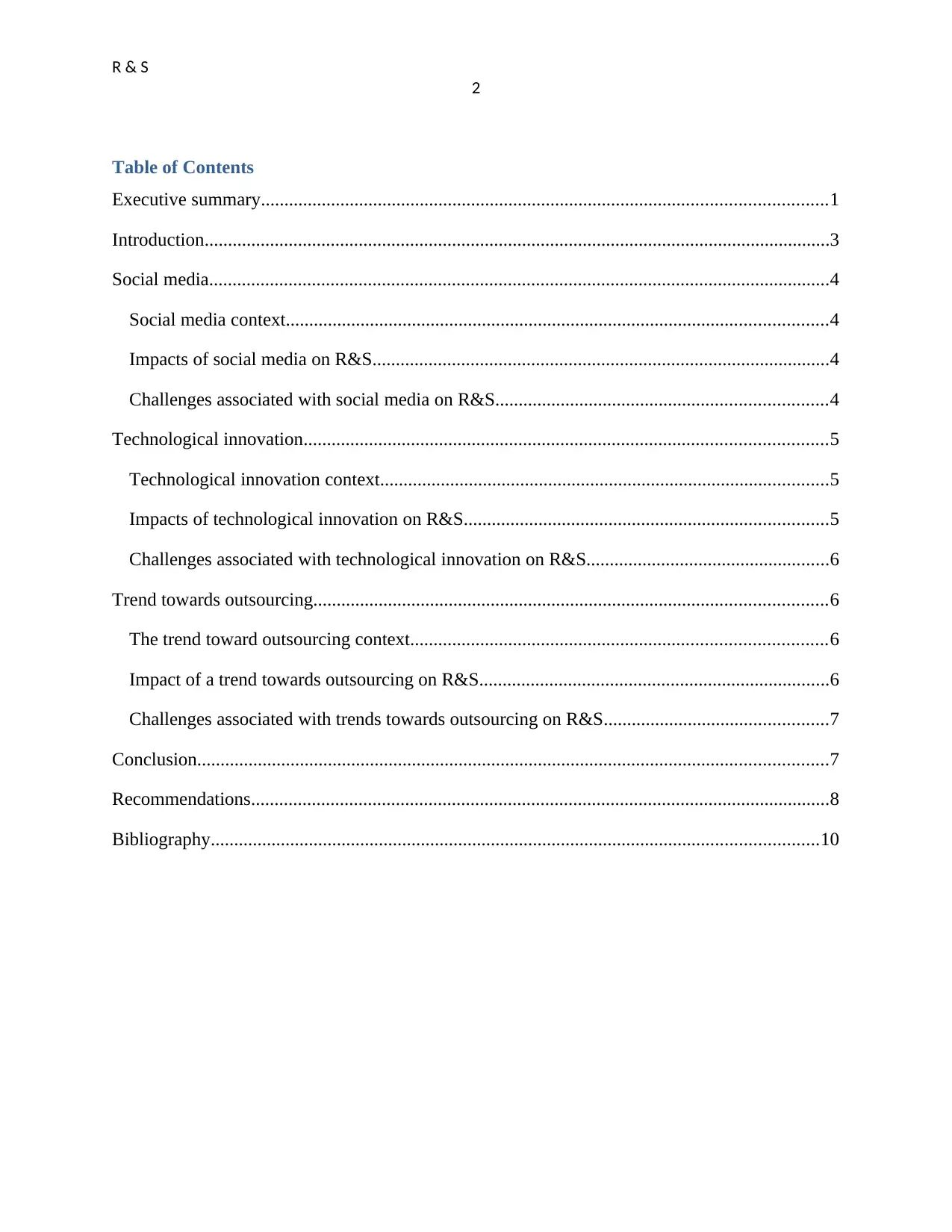
R & S
2
Table of Contents
Executive summary.........................................................................................................................1
Introduction......................................................................................................................................3
Social media.....................................................................................................................................4
Social media context....................................................................................................................4
Impacts of social media on R&S..................................................................................................4
Challenges associated with social media on R&S.......................................................................4
Technological innovation................................................................................................................5
Technological innovation context................................................................................................5
Impacts of technological innovation on R&S..............................................................................5
Challenges associated with technological innovation on R&S....................................................6
Trend towards outsourcing..............................................................................................................6
The trend toward outsourcing context.........................................................................................6
Impact of a trend towards outsourcing on R&S...........................................................................6
Challenges associated with trends towards outsourcing on R&S................................................7
Conclusion.......................................................................................................................................7
Recommendations............................................................................................................................8
Bibliography..................................................................................................................................10
2
Table of Contents
Executive summary.........................................................................................................................1
Introduction......................................................................................................................................3
Social media.....................................................................................................................................4
Social media context....................................................................................................................4
Impacts of social media on R&S..................................................................................................4
Challenges associated with social media on R&S.......................................................................4
Technological innovation................................................................................................................5
Technological innovation context................................................................................................5
Impacts of technological innovation on R&S..............................................................................5
Challenges associated with technological innovation on R&S....................................................6
Trend towards outsourcing..............................................................................................................6
The trend toward outsourcing context.........................................................................................6
Impact of a trend towards outsourcing on R&S...........................................................................6
Challenges associated with trends towards outsourcing on R&S................................................7
Conclusion.......................................................................................................................................7
Recommendations............................................................................................................................8
Bibliography..................................................................................................................................10
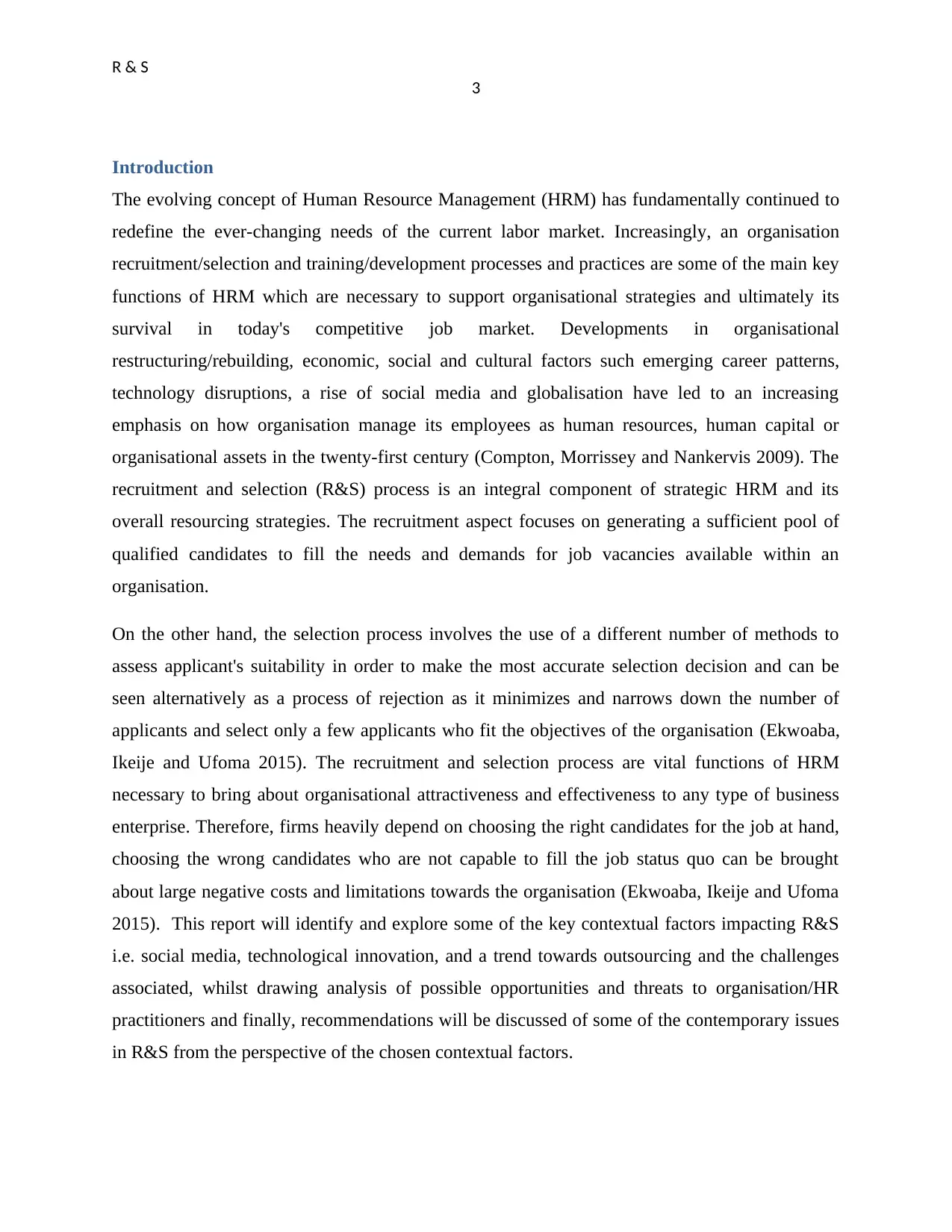
R & S
3
Introduction
The evolving concept of Human Resource Management (HRM) has fundamentally continued to
redefine the ever-changing needs of the current labor market. Increasingly, an organisation
recruitment/selection and training/development processes and practices are some of the main key
functions of HRM which are necessary to support organisational strategies and ultimately its
survival in today's competitive job market. Developments in organisational
restructuring/rebuilding, economic, social and cultural factors such emerging career patterns,
technology disruptions, a rise of social media and globalisation have led to an increasing
emphasis on how organisation manage its employees as human resources, human capital or
organisational assets in the twenty-first century (Compton, Morrissey and Nankervis 2009). The
recruitment and selection (R&S) process is an integral component of strategic HRM and its
overall resourcing strategies. The recruitment aspect focuses on generating a sufficient pool of
qualified candidates to fill the needs and demands for job vacancies available within an
organisation.
On the other hand, the selection process involves the use of a different number of methods to
assess applicant's suitability in order to make the most accurate selection decision and can be
seen alternatively as a process of rejection as it minimizes and narrows down the number of
applicants and select only a few applicants who fit the objectives of the organisation (Ekwoaba,
Ikeije and Ufoma 2015). The recruitment and selection process are vital functions of HRM
necessary to bring about organisational attractiveness and effectiveness to any type of business
enterprise. Therefore, firms heavily depend on choosing the right candidates for the job at hand,
choosing the wrong candidates who are not capable to fill the job status quo can be brought
about large negative costs and limitations towards the organisation (Ekwoaba, Ikeije and Ufoma
2015). This report will identify and explore some of the key contextual factors impacting R&S
i.e. social media, technological innovation, and a trend towards outsourcing and the challenges
associated, whilst drawing analysis of possible opportunities and threats to organisation/HR
practitioners and finally, recommendations will be discussed of some of the contemporary issues
in R&S from the perspective of the chosen contextual factors.
3
Introduction
The evolving concept of Human Resource Management (HRM) has fundamentally continued to
redefine the ever-changing needs of the current labor market. Increasingly, an organisation
recruitment/selection and training/development processes and practices are some of the main key
functions of HRM which are necessary to support organisational strategies and ultimately its
survival in today's competitive job market. Developments in organisational
restructuring/rebuilding, economic, social and cultural factors such emerging career patterns,
technology disruptions, a rise of social media and globalisation have led to an increasing
emphasis on how organisation manage its employees as human resources, human capital or
organisational assets in the twenty-first century (Compton, Morrissey and Nankervis 2009). The
recruitment and selection (R&S) process is an integral component of strategic HRM and its
overall resourcing strategies. The recruitment aspect focuses on generating a sufficient pool of
qualified candidates to fill the needs and demands for job vacancies available within an
organisation.
On the other hand, the selection process involves the use of a different number of methods to
assess applicant's suitability in order to make the most accurate selection decision and can be
seen alternatively as a process of rejection as it minimizes and narrows down the number of
applicants and select only a few applicants who fit the objectives of the organisation (Ekwoaba,
Ikeije and Ufoma 2015). The recruitment and selection process are vital functions of HRM
necessary to bring about organisational attractiveness and effectiveness to any type of business
enterprise. Therefore, firms heavily depend on choosing the right candidates for the job at hand,
choosing the wrong candidates who are not capable to fill the job status quo can be brought
about large negative costs and limitations towards the organisation (Ekwoaba, Ikeije and Ufoma
2015). This report will identify and explore some of the key contextual factors impacting R&S
i.e. social media, technological innovation, and a trend towards outsourcing and the challenges
associated, whilst drawing analysis of possible opportunities and threats to organisation/HR
practitioners and finally, recommendations will be discussed of some of the contemporary issues
in R&S from the perspective of the chosen contextual factors.
Secure Best Marks with AI Grader
Need help grading? Try our AI Grader for instant feedback on your assignments.
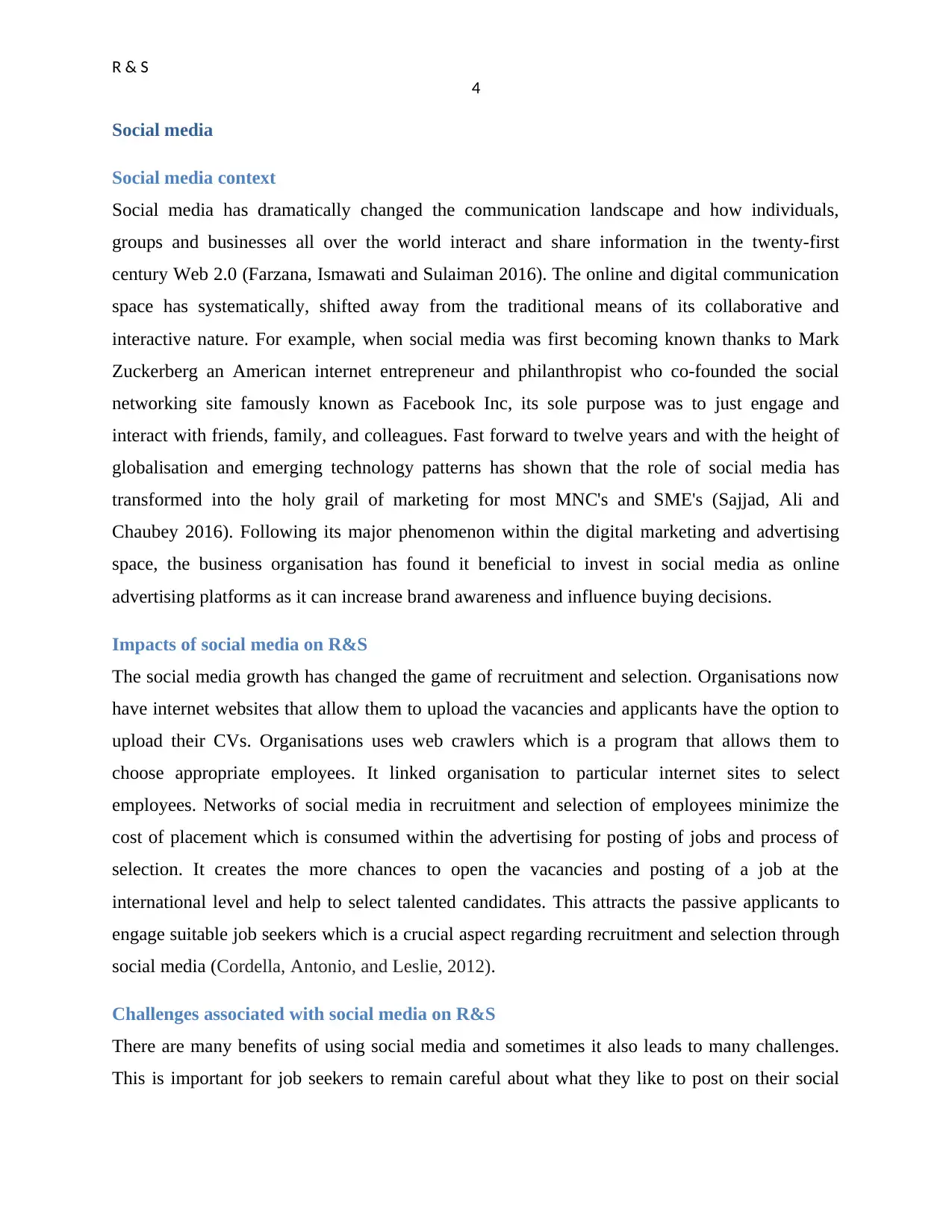
R & S
4
Social media
Social media context
Social media has dramatically changed the communication landscape and how individuals,
groups and businesses all over the world interact and share information in the twenty-first
century Web 2.0 (Farzana, Ismawati and Sulaiman 2016). The online and digital communication
space has systematically, shifted away from the traditional means of its collaborative and
interactive nature. For example, when social media was first becoming known thanks to Mark
Zuckerberg an American internet entrepreneur and philanthropist who co-founded the social
networking site famously known as Facebook Inc, its sole purpose was to just engage and
interact with friends, family, and colleagues. Fast forward to twelve years and with the height of
globalisation and emerging technology patterns has shown that the role of social media has
transformed into the holy grail of marketing for most MNC's and SME's (Sajjad, Ali and
Chaubey 2016). Following its major phenomenon within the digital marketing and advertising
space, the business organisation has found it beneficial to invest in social media as online
advertising platforms as it can increase brand awareness and influence buying decisions.
Impacts of social media on R&S
The social media growth has changed the game of recruitment and selection. Organisations now
have internet websites that allow them to upload the vacancies and applicants have the option to
upload their CVs. Organisations uses web crawlers which is a program that allows them to
choose appropriate employees. It linked organisation to particular internet sites to select
employees. Networks of social media in recruitment and selection of employees minimize the
cost of placement which is consumed within the advertising for posting of jobs and process of
selection. It creates the more chances to open the vacancies and posting of a job at the
international level and help to select talented candidates. This attracts the passive applicants to
engage suitable job seekers which is a crucial aspect regarding recruitment and selection through
social media (Cordella, Antonio, and Leslie, 2012).
Challenges associated with social media on R&S
There are many benefits of using social media and sometimes it also leads to many challenges.
This is important for job seekers to remain careful about what they like to post on their social
4
Social media
Social media context
Social media has dramatically changed the communication landscape and how individuals,
groups and businesses all over the world interact and share information in the twenty-first
century Web 2.0 (Farzana, Ismawati and Sulaiman 2016). The online and digital communication
space has systematically, shifted away from the traditional means of its collaborative and
interactive nature. For example, when social media was first becoming known thanks to Mark
Zuckerberg an American internet entrepreneur and philanthropist who co-founded the social
networking site famously known as Facebook Inc, its sole purpose was to just engage and
interact with friends, family, and colleagues. Fast forward to twelve years and with the height of
globalisation and emerging technology patterns has shown that the role of social media has
transformed into the holy grail of marketing for most MNC's and SME's (Sajjad, Ali and
Chaubey 2016). Following its major phenomenon within the digital marketing and advertising
space, the business organisation has found it beneficial to invest in social media as online
advertising platforms as it can increase brand awareness and influence buying decisions.
Impacts of social media on R&S
The social media growth has changed the game of recruitment and selection. Organisations now
have internet websites that allow them to upload the vacancies and applicants have the option to
upload their CVs. Organisations uses web crawlers which is a program that allows them to
choose appropriate employees. It linked organisation to particular internet sites to select
employees. Networks of social media in recruitment and selection of employees minimize the
cost of placement which is consumed within the advertising for posting of jobs and process of
selection. It creates the more chances to open the vacancies and posting of a job at the
international level and help to select talented candidates. This attracts the passive applicants to
engage suitable job seekers which is a crucial aspect regarding recruitment and selection through
social media (Cordella, Antonio, and Leslie, 2012).
Challenges associated with social media on R&S
There are many benefits of using social media and sometimes it also leads to many challenges.
This is important for job seekers to remain careful about what they like to post on their social
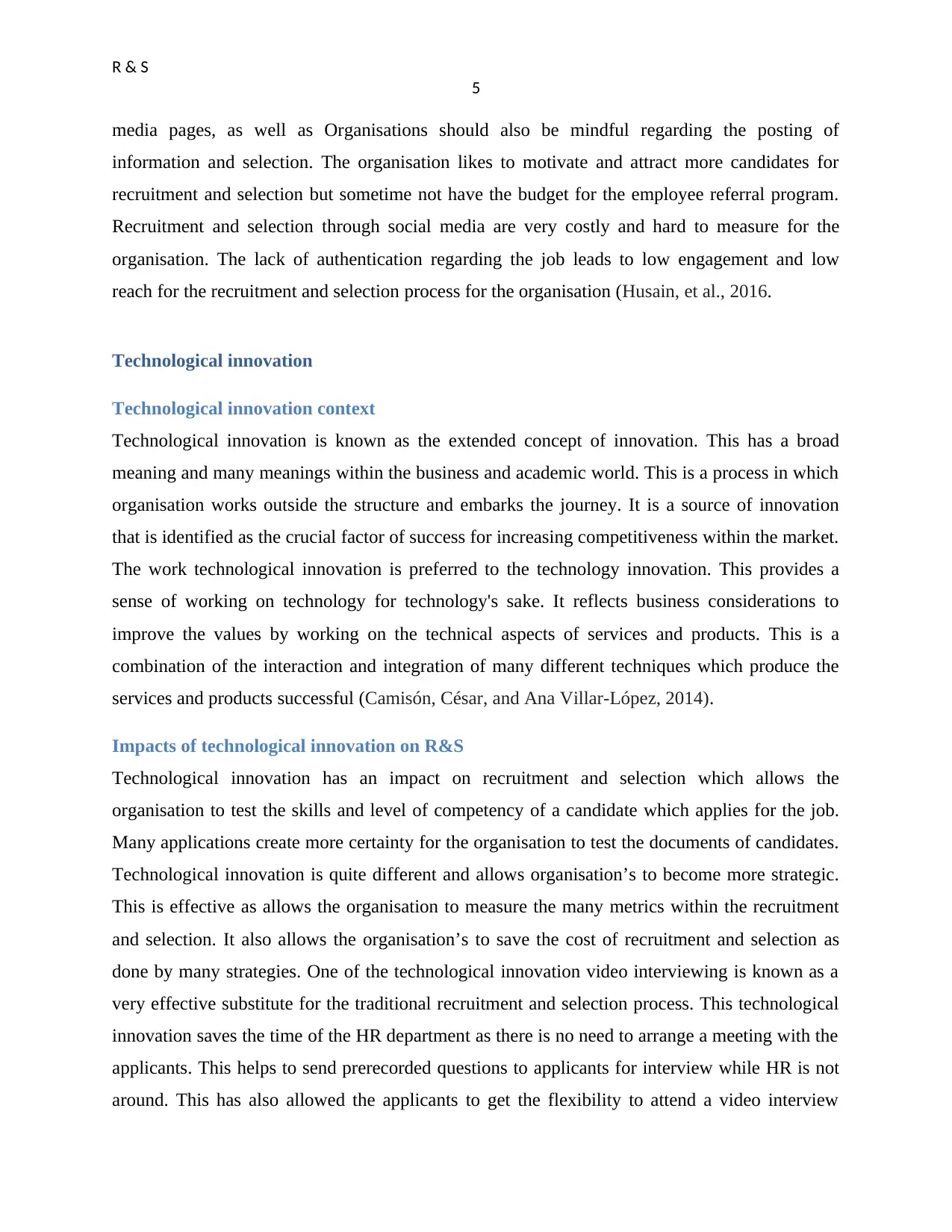
R & S
5
media pages, as well as Organisations should also be mindful regarding the posting of
information and selection. The organisation likes to motivate and attract more candidates for
recruitment and selection but sometime not have the budget for the employee referral program.
Recruitment and selection through social media are very costly and hard to measure for the
organisation. The lack of authentication regarding the job leads to low engagement and low
reach for the recruitment and selection process for the organisation (Husain, et al., 2016.
Technological innovation
Technological innovation context
Technological innovation is known as the extended concept of innovation. This has a broad
meaning and many meanings within the business and academic world. This is a process in which
organisation works outside the structure and embarks the journey. It is a source of innovation
that is identified as the crucial factor of success for increasing competitiveness within the market.
The work technological innovation is preferred to the technology innovation. This provides a
sense of working on technology for technology's sake. It reflects business considerations to
improve the values by working on the technical aspects of services and products. This is a
combination of the interaction and integration of many different techniques which produce the
services and products successful (Camisón, César, and Ana Villar-López, 2014).
Impacts of technological innovation on R&S
Technological innovation has an impact on recruitment and selection which allows the
organisation to test the skills and level of competency of a candidate which applies for the job.
Many applications create more certainty for the organisation to test the documents of candidates.
Technological innovation is quite different and allows organisation’s to become more strategic.
This is effective as allows the organisation to measure the many metrics within the recruitment
and selection. It also allows the organisation’s to save the cost of recruitment and selection as
done by many strategies. One of the technological innovation video interviewing is known as a
very effective substitute for the traditional recruitment and selection process. This technological
innovation saves the time of the HR department as there is no need to arrange a meeting with the
applicants. This helps to send prerecorded questions to applicants for interview while HR is not
around. This has also allowed the applicants to get the flexibility to attend a video interview
5
media pages, as well as Organisations should also be mindful regarding the posting of
information and selection. The organisation likes to motivate and attract more candidates for
recruitment and selection but sometime not have the budget for the employee referral program.
Recruitment and selection through social media are very costly and hard to measure for the
organisation. The lack of authentication regarding the job leads to low engagement and low
reach for the recruitment and selection process for the organisation (Husain, et al., 2016.
Technological innovation
Technological innovation context
Technological innovation is known as the extended concept of innovation. This has a broad
meaning and many meanings within the business and academic world. This is a process in which
organisation works outside the structure and embarks the journey. It is a source of innovation
that is identified as the crucial factor of success for increasing competitiveness within the market.
The work technological innovation is preferred to the technology innovation. This provides a
sense of working on technology for technology's sake. It reflects business considerations to
improve the values by working on the technical aspects of services and products. This is a
combination of the interaction and integration of many different techniques which produce the
services and products successful (Camisón, César, and Ana Villar-López, 2014).
Impacts of technological innovation on R&S
Technological innovation has an impact on recruitment and selection which allows the
organisation to test the skills and level of competency of a candidate which applies for the job.
Many applications create more certainty for the organisation to test the documents of candidates.
Technological innovation is quite different and allows organisation’s to become more strategic.
This is effective as allows the organisation to measure the many metrics within the recruitment
and selection. It also allows the organisation’s to save the cost of recruitment and selection as
done by many strategies. One of the technological innovation video interviewing is known as a
very effective substitute for the traditional recruitment and selection process. This technological
innovation saves the time of the HR department as there is no need to arrange a meeting with the
applicants. This helps to send prerecorded questions to applicants for interview while HR is not
around. This has also allowed the applicants to get the flexibility to attend a video interview
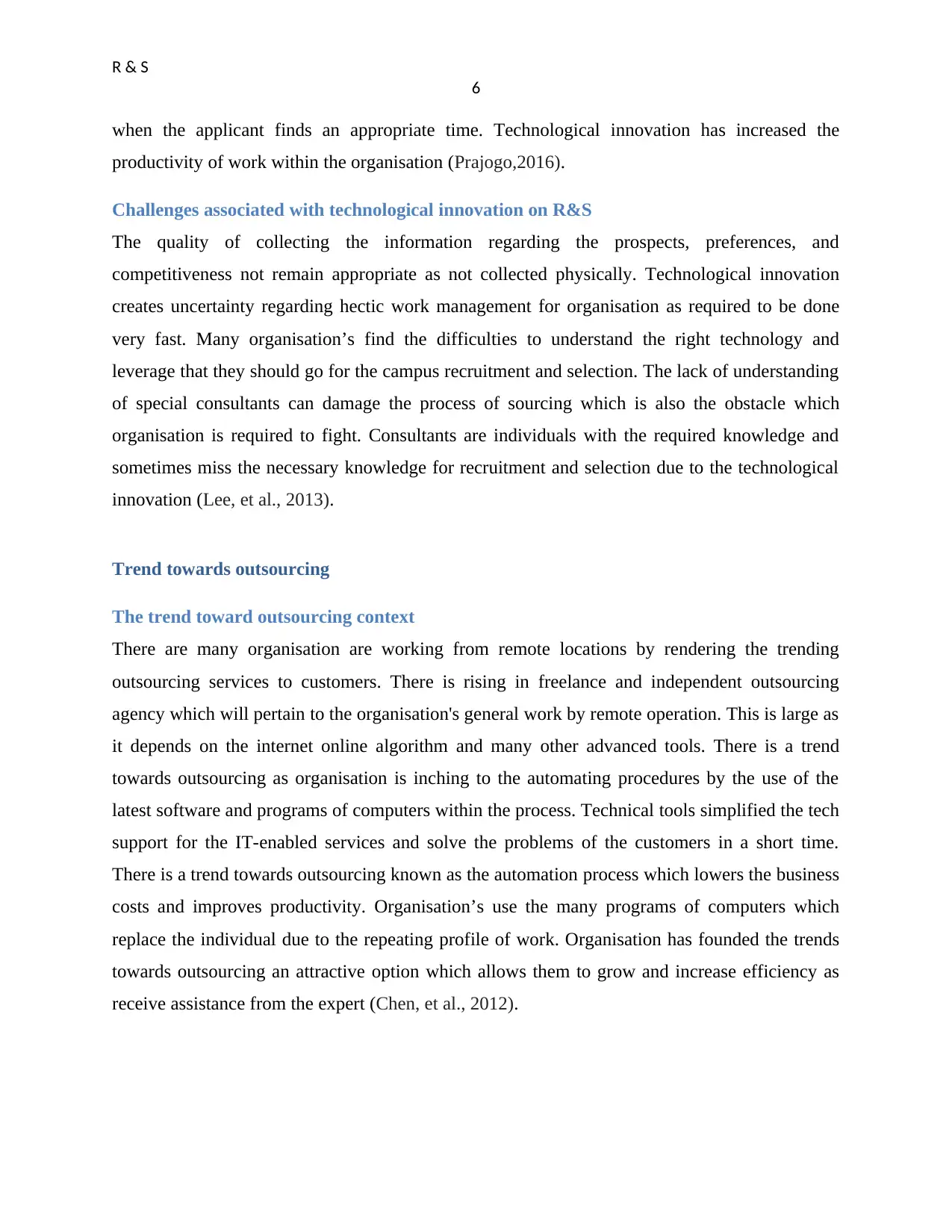
R & S
6
when the applicant finds an appropriate time. Technological innovation has increased the
productivity of work within the organisation (Prajogo,2016).
Challenges associated with technological innovation on R&S
The quality of collecting the information regarding the prospects, preferences, and
competitiveness not remain appropriate as not collected physically. Technological innovation
creates uncertainty regarding hectic work management for organisation as required to be done
very fast. Many organisation’s find the difficulties to understand the right technology and
leverage that they should go for the campus recruitment and selection. The lack of understanding
of special consultants can damage the process of sourcing which is also the obstacle which
organisation is required to fight. Consultants are individuals with the required knowledge and
sometimes miss the necessary knowledge for recruitment and selection due to the technological
innovation (Lee, et al., 2013).
Trend towards outsourcing
The trend toward outsourcing context
There are many organisation are working from remote locations by rendering the trending
outsourcing services to customers. There is rising in freelance and independent outsourcing
agency which will pertain to the organisation's general work by remote operation. This is large as
it depends on the internet online algorithm and many other advanced tools. There is a trend
towards outsourcing as organisation is inching to the automating procedures by the use of the
latest software and programs of computers within the process. Technical tools simplified the tech
support for the IT-enabled services and solve the problems of the customers in a short time.
There is a trend towards outsourcing known as the automation process which lowers the business
costs and improves productivity. Organisation’s use the many programs of computers which
replace the individual due to the repeating profile of work. Organisation has founded the trends
towards outsourcing an attractive option which allows them to grow and increase efficiency as
receive assistance from the expert (Chen, et al., 2012).
6
when the applicant finds an appropriate time. Technological innovation has increased the
productivity of work within the organisation (Prajogo,2016).
Challenges associated with technological innovation on R&S
The quality of collecting the information regarding the prospects, preferences, and
competitiveness not remain appropriate as not collected physically. Technological innovation
creates uncertainty regarding hectic work management for organisation as required to be done
very fast. Many organisation’s find the difficulties to understand the right technology and
leverage that they should go for the campus recruitment and selection. The lack of understanding
of special consultants can damage the process of sourcing which is also the obstacle which
organisation is required to fight. Consultants are individuals with the required knowledge and
sometimes miss the necessary knowledge for recruitment and selection due to the technological
innovation (Lee, et al., 2013).
Trend towards outsourcing
The trend toward outsourcing context
There are many organisation are working from remote locations by rendering the trending
outsourcing services to customers. There is rising in freelance and independent outsourcing
agency which will pertain to the organisation's general work by remote operation. This is large as
it depends on the internet online algorithm and many other advanced tools. There is a trend
towards outsourcing as organisation is inching to the automating procedures by the use of the
latest software and programs of computers within the process. Technical tools simplified the tech
support for the IT-enabled services and solve the problems of the customers in a short time.
There is a trend towards outsourcing known as the automation process which lowers the business
costs and improves productivity. Organisation’s use the many programs of computers which
replace the individual due to the repeating profile of work. Organisation has founded the trends
towards outsourcing an attractive option which allows them to grow and increase efficiency as
receive assistance from the expert (Chen, et al., 2012).
Paraphrase This Document
Need a fresh take? Get an instant paraphrase of this document with our AI Paraphraser
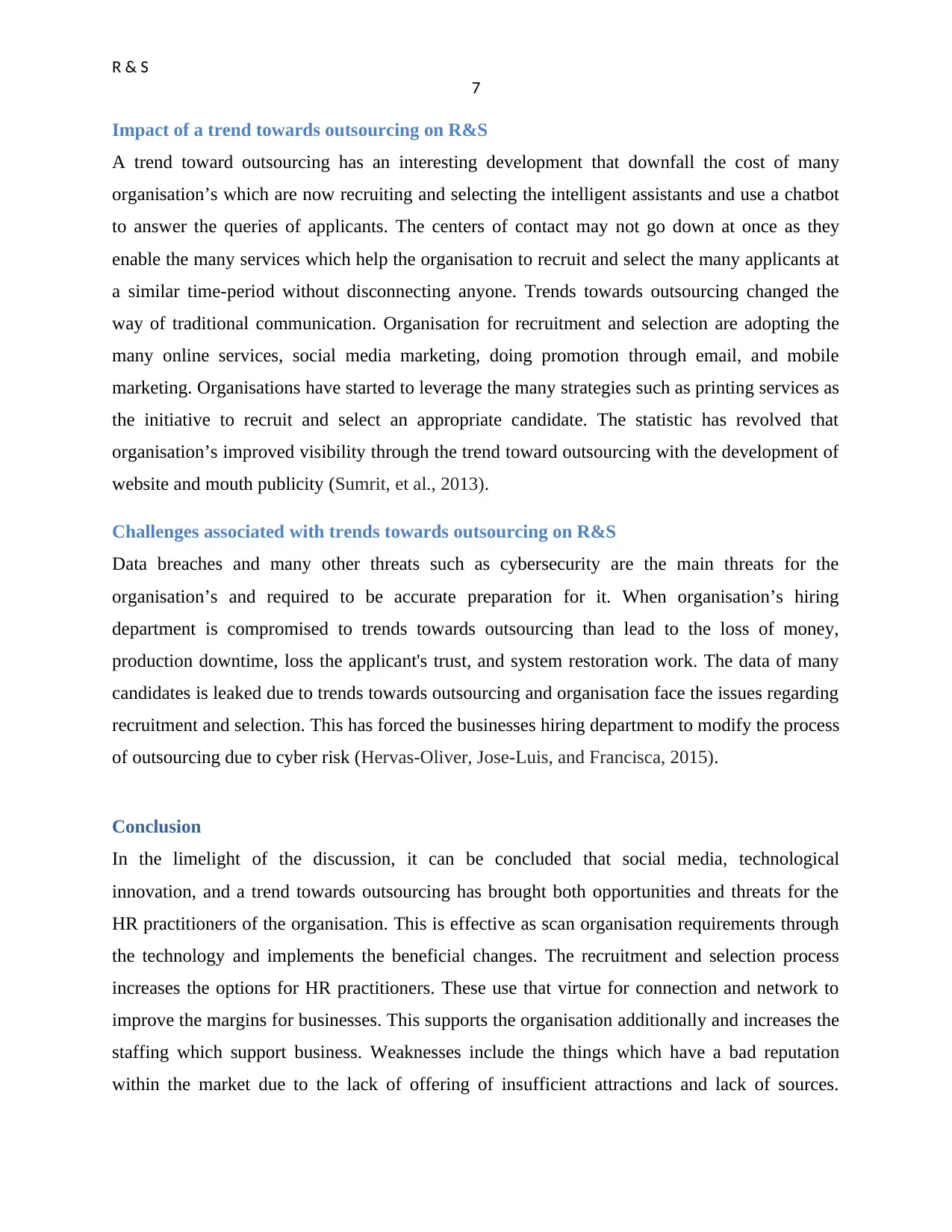
R & S
7
Impact of a trend towards outsourcing on R&S
A trend toward outsourcing has an interesting development that downfall the cost of many
organisation’s which are now recruiting and selecting the intelligent assistants and use a chatbot
to answer the queries of applicants. The centers of contact may not go down at once as they
enable the many services which help the organisation to recruit and select the many applicants at
a similar time-period without disconnecting anyone. Trends towards outsourcing changed the
way of traditional communication. Organisation for recruitment and selection are adopting the
many online services, social media marketing, doing promotion through email, and mobile
marketing. Organisations have started to leverage the many strategies such as printing services as
the initiative to recruit and select an appropriate candidate. The statistic has revolved that
organisation’s improved visibility through the trend toward outsourcing with the development of
website and mouth publicity (Sumrit, et al., 2013).
Challenges associated with trends towards outsourcing on R&S
Data breaches and many other threats such as cybersecurity are the main threats for the
organisation’s and required to be accurate preparation for it. When organisation’s hiring
department is compromised to trends towards outsourcing than lead to the loss of money,
production downtime, loss the applicant's trust, and system restoration work. The data of many
candidates is leaked due to trends towards outsourcing and organisation face the issues regarding
recruitment and selection. This has forced the businesses hiring department to modify the process
of outsourcing due to cyber risk (Hervas-Oliver, Jose-Luis, and Francisca, 2015).
Conclusion
In the limelight of the discussion, it can be concluded that social media, technological
innovation, and a trend towards outsourcing has brought both opportunities and threats for the
HR practitioners of the organisation. This is effective as scan organisation requirements through
the technology and implements the beneficial changes. The recruitment and selection process
increases the options for HR practitioners. These use that virtue for connection and network to
improve the margins for businesses. This supports the organisation additionally and increases the
staffing which support business. Weaknesses include the things which have a bad reputation
within the market due to the lack of offering of insufficient attractions and lack of sources.
7
Impact of a trend towards outsourcing on R&S
A trend toward outsourcing has an interesting development that downfall the cost of many
organisation’s which are now recruiting and selecting the intelligent assistants and use a chatbot
to answer the queries of applicants. The centers of contact may not go down at once as they
enable the many services which help the organisation to recruit and select the many applicants at
a similar time-period without disconnecting anyone. Trends towards outsourcing changed the
way of traditional communication. Organisation for recruitment and selection are adopting the
many online services, social media marketing, doing promotion through email, and mobile
marketing. Organisations have started to leverage the many strategies such as printing services as
the initiative to recruit and select an appropriate candidate. The statistic has revolved that
organisation’s improved visibility through the trend toward outsourcing with the development of
website and mouth publicity (Sumrit, et al., 2013).
Challenges associated with trends towards outsourcing on R&S
Data breaches and many other threats such as cybersecurity are the main threats for the
organisation’s and required to be accurate preparation for it. When organisation’s hiring
department is compromised to trends towards outsourcing than lead to the loss of money,
production downtime, loss the applicant's trust, and system restoration work. The data of many
candidates is leaked due to trends towards outsourcing and organisation face the issues regarding
recruitment and selection. This has forced the businesses hiring department to modify the process
of outsourcing due to cyber risk (Hervas-Oliver, Jose-Luis, and Francisca, 2015).
Conclusion
In the limelight of the discussion, it can be concluded that social media, technological
innovation, and a trend towards outsourcing has brought both opportunities and threats for the
HR practitioners of the organisation. This is effective as scan organisation requirements through
the technology and implements the beneficial changes. The recruitment and selection process
increases the options for HR practitioners. These use that virtue for connection and network to
improve the margins for businesses. This supports the organisation additionally and increases the
staffing which support business. Weaknesses include the things which have a bad reputation
within the market due to the lack of offering of insufficient attractions and lack of sources.
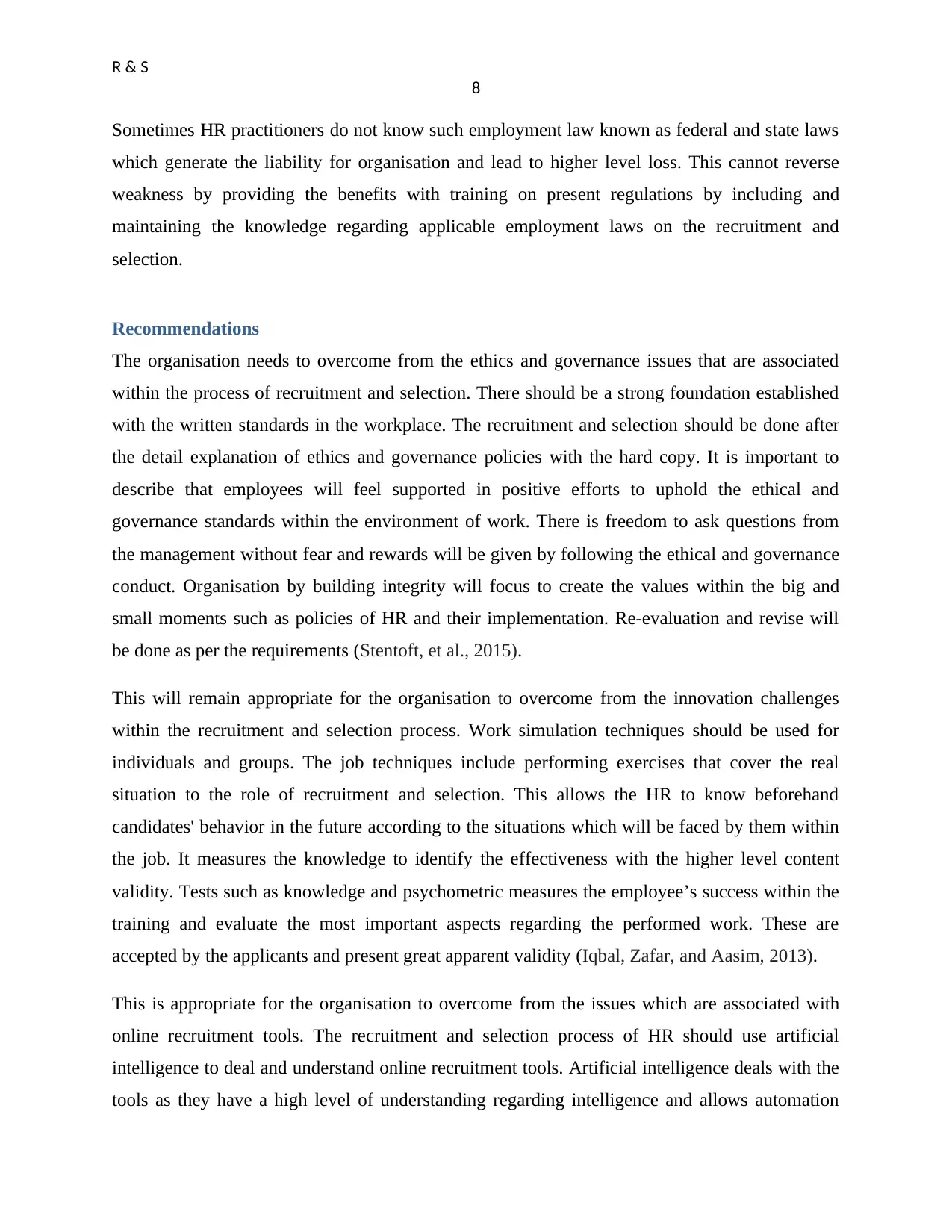
R & S
8
Sometimes HR practitioners do not know such employment law known as federal and state laws
which generate the liability for organisation and lead to higher level loss. This cannot reverse
weakness by providing the benefits with training on present regulations by including and
maintaining the knowledge regarding applicable employment laws on the recruitment and
selection.
Recommendations
The organisation needs to overcome from the ethics and governance issues that are associated
within the process of recruitment and selection. There should be a strong foundation established
with the written standards in the workplace. The recruitment and selection should be done after
the detail explanation of ethics and governance policies with the hard copy. It is important to
describe that employees will feel supported in positive efforts to uphold the ethical and
governance standards within the environment of work. There is freedom to ask questions from
the management without fear and rewards will be given by following the ethical and governance
conduct. Organisation by building integrity will focus to create the values within the big and
small moments such as policies of HR and their implementation. Re-evaluation and revise will
be done as per the requirements (Stentoft, et al., 2015).
This will remain appropriate for the organisation to overcome from the innovation challenges
within the recruitment and selection process. Work simulation techniques should be used for
individuals and groups. The job techniques include performing exercises that cover the real
situation to the role of recruitment and selection. This allows the HR to know beforehand
candidates' behavior in the future according to the situations which will be faced by them within
the job. It measures the knowledge to identify the effectiveness with the higher level content
validity. Tests such as knowledge and psychometric measures the employee’s success within the
training and evaluate the most important aspects regarding the performed work. These are
accepted by the applicants and present great apparent validity (Iqbal, Zafar, and Aasim, 2013).
This is appropriate for the organisation to overcome from the issues which are associated with
online recruitment tools. The recruitment and selection process of HR should use artificial
intelligence to deal and understand online recruitment tools. Artificial intelligence deals with the
tools as they have a high level of understanding regarding intelligence and allows automation
8
Sometimes HR practitioners do not know such employment law known as federal and state laws
which generate the liability for organisation and lead to higher level loss. This cannot reverse
weakness by providing the benefits with training on present regulations by including and
maintaining the knowledge regarding applicable employment laws on the recruitment and
selection.
Recommendations
The organisation needs to overcome from the ethics and governance issues that are associated
within the process of recruitment and selection. There should be a strong foundation established
with the written standards in the workplace. The recruitment and selection should be done after
the detail explanation of ethics and governance policies with the hard copy. It is important to
describe that employees will feel supported in positive efforts to uphold the ethical and
governance standards within the environment of work. There is freedom to ask questions from
the management without fear and rewards will be given by following the ethical and governance
conduct. Organisation by building integrity will focus to create the values within the big and
small moments such as policies of HR and their implementation. Re-evaluation and revise will
be done as per the requirements (Stentoft, et al., 2015).
This will remain appropriate for the organisation to overcome from the innovation challenges
within the recruitment and selection process. Work simulation techniques should be used for
individuals and groups. The job techniques include performing exercises that cover the real
situation to the role of recruitment and selection. This allows the HR to know beforehand
candidates' behavior in the future according to the situations which will be faced by them within
the job. It measures the knowledge to identify the effectiveness with the higher level content
validity. Tests such as knowledge and psychometric measures the employee’s success within the
training and evaluate the most important aspects regarding the performed work. These are
accepted by the applicants and present great apparent validity (Iqbal, Zafar, and Aasim, 2013).
This is appropriate for the organisation to overcome from the issues which are associated with
online recruitment tools. The recruitment and selection process of HR should use artificial
intelligence to deal and understand online recruitment tools. Artificial intelligence deals with the
tools as they have a high level of understanding regarding intelligence and allows automation
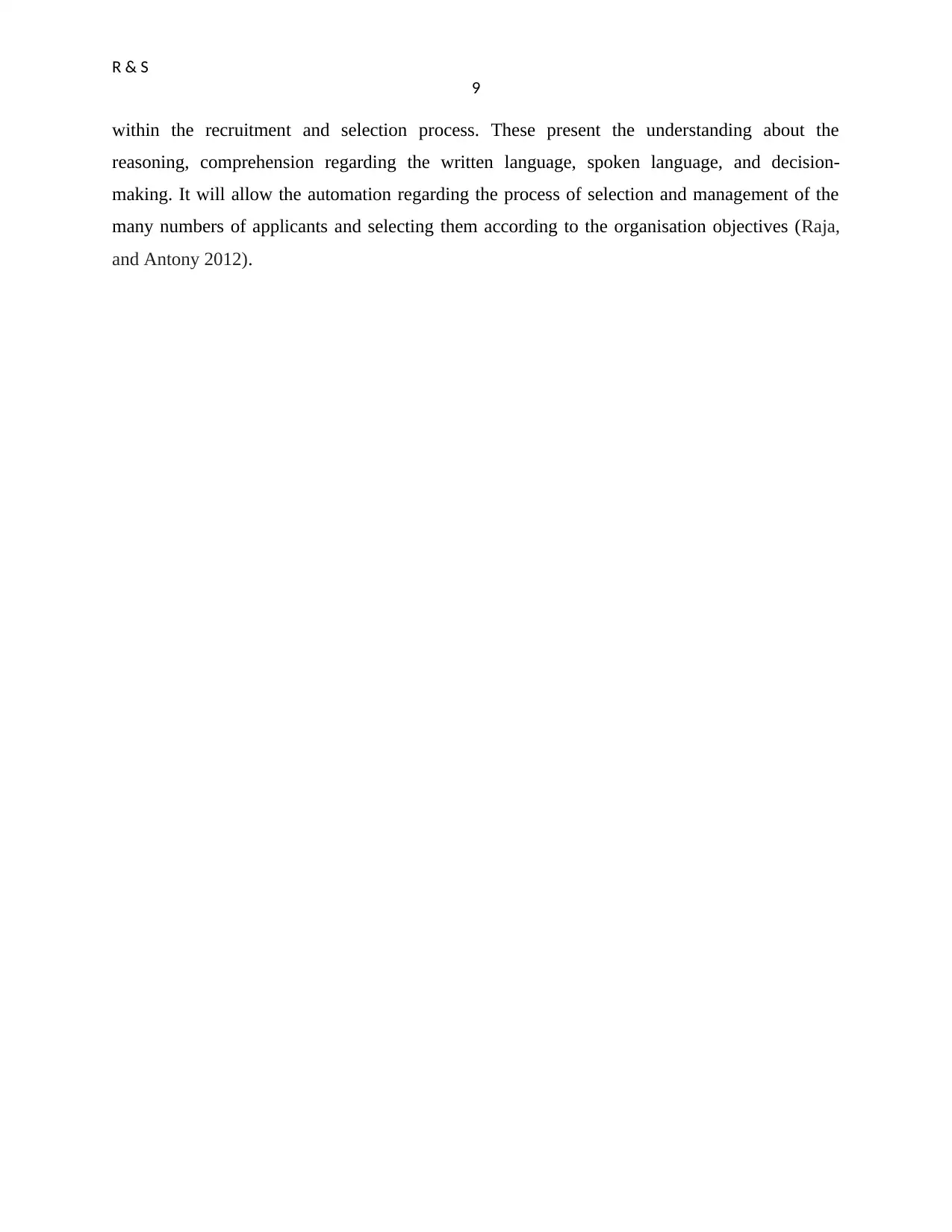
R & S
9
within the recruitment and selection process. These present the understanding about the
reasoning, comprehension regarding the written language, spoken language, and decision-
making. It will allow the automation regarding the process of selection and management of the
many numbers of applicants and selecting them according to the organisation objectives (Raja,
and Antony 2012).
9
within the recruitment and selection process. These present the understanding about the
reasoning, comprehension regarding the written language, spoken language, and decision-
making. It will allow the automation regarding the process of selection and management of the
many numbers of applicants and selecting them according to the organisation objectives (Raja,
and Antony 2012).
Secure Best Marks with AI Grader
Need help grading? Try our AI Grader for instant feedback on your assignments.
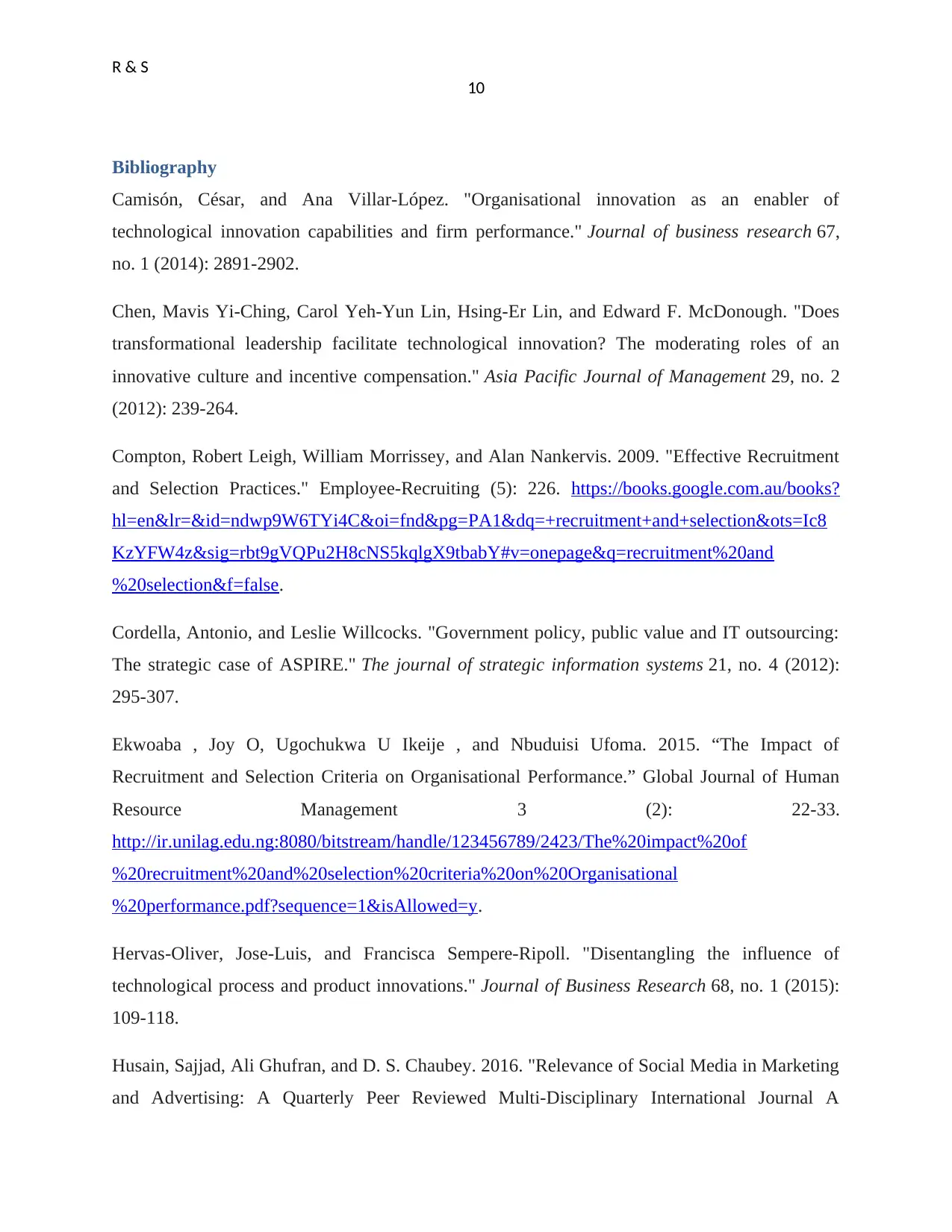
R & S
10
Bibliography
Camisón, César, and Ana Villar-López. "Organisational innovation as an enabler of
technological innovation capabilities and firm performance." Journal of business research 67,
no. 1 (2014): 2891-2902.
Chen, Mavis Yi-Ching, Carol Yeh-Yun Lin, Hsing-Er Lin, and Edward F. McDonough. "Does
transformational leadership facilitate technological innovation? The moderating roles of an
innovative culture and incentive compensation." Asia Pacific Journal of Management 29, no. 2
(2012): 239-264.
Compton, Robert Leigh, William Morrissey, and Alan Nankervis. 2009. "Effective Recruitment
and Selection Practices." Employee-Recruiting (5): 226. https://books.google.com.au/books?
hl=en&lr=&id=ndwp9W6TYi4C&oi=fnd&pg=PA1&dq=+recruitment+and+selection&ots=Ic8
KzYFW4z&sig=rbt9gVQPu2H8cNS5kqlgX9tbabY#v=onepage&q=recruitment%20and
%20selection&f=false.
Cordella, Antonio, and Leslie Willcocks. "Government policy, public value and IT outsourcing:
The strategic case of ASPIRE." The journal of strategic information systems 21, no. 4 (2012):
295-307.
Ekwoaba , Joy O, Ugochukwa U Ikeije , and Nbuduisi Ufoma. 2015. “The Impact of
Recruitment and Selection Criteria on Organisational Performance.” Global Journal of Human
Resource Management 3 (2): 22-33.
http://ir.unilag.edu.ng:8080/bitstream/handle/123456789/2423/The%20impact%20of
%20recruitment%20and%20selection%20criteria%20on%20Organisational
%20performance.pdf?sequence=1&isAllowed=y.
Hervas-Oliver, Jose-Luis, and Francisca Sempere-Ripoll. "Disentangling the influence of
technological process and product innovations." Journal of Business Research 68, no. 1 (2015):
109-118.
Husain, Sajjad, Ali Ghufran, and D. S. Chaubey. 2016. "Relevance of Social Media in Marketing
and Advertising: A Quarterly Peer Reviewed Multi-Disciplinary International Journal A
10
Bibliography
Camisón, César, and Ana Villar-López. "Organisational innovation as an enabler of
technological innovation capabilities and firm performance." Journal of business research 67,
no. 1 (2014): 2891-2902.
Chen, Mavis Yi-Ching, Carol Yeh-Yun Lin, Hsing-Er Lin, and Edward F. McDonough. "Does
transformational leadership facilitate technological innovation? The moderating roles of an
innovative culture and incentive compensation." Asia Pacific Journal of Management 29, no. 2
(2012): 239-264.
Compton, Robert Leigh, William Morrissey, and Alan Nankervis. 2009. "Effective Recruitment
and Selection Practices." Employee-Recruiting (5): 226. https://books.google.com.au/books?
hl=en&lr=&id=ndwp9W6TYi4C&oi=fnd&pg=PA1&dq=+recruitment+and+selection&ots=Ic8
KzYFW4z&sig=rbt9gVQPu2H8cNS5kqlgX9tbabY#v=onepage&q=recruitment%20and
%20selection&f=false.
Cordella, Antonio, and Leslie Willcocks. "Government policy, public value and IT outsourcing:
The strategic case of ASPIRE." The journal of strategic information systems 21, no. 4 (2012):
295-307.
Ekwoaba , Joy O, Ugochukwa U Ikeije , and Nbuduisi Ufoma. 2015. “The Impact of
Recruitment and Selection Criteria on Organisational Performance.” Global Journal of Human
Resource Management 3 (2): 22-33.
http://ir.unilag.edu.ng:8080/bitstream/handle/123456789/2423/The%20impact%20of
%20recruitment%20and%20selection%20criteria%20on%20Organisational
%20performance.pdf?sequence=1&isAllowed=y.
Hervas-Oliver, Jose-Luis, and Francisca Sempere-Ripoll. "Disentangling the influence of
technological process and product innovations." Journal of Business Research 68, no. 1 (2015):
109-118.
Husain, Sajjad, Ali Ghufran, and D. S. Chaubey. 2016. "Relevance of Social Media in Marketing
and Advertising: A Quarterly Peer Reviewed Multi-Disciplinary International Journal A
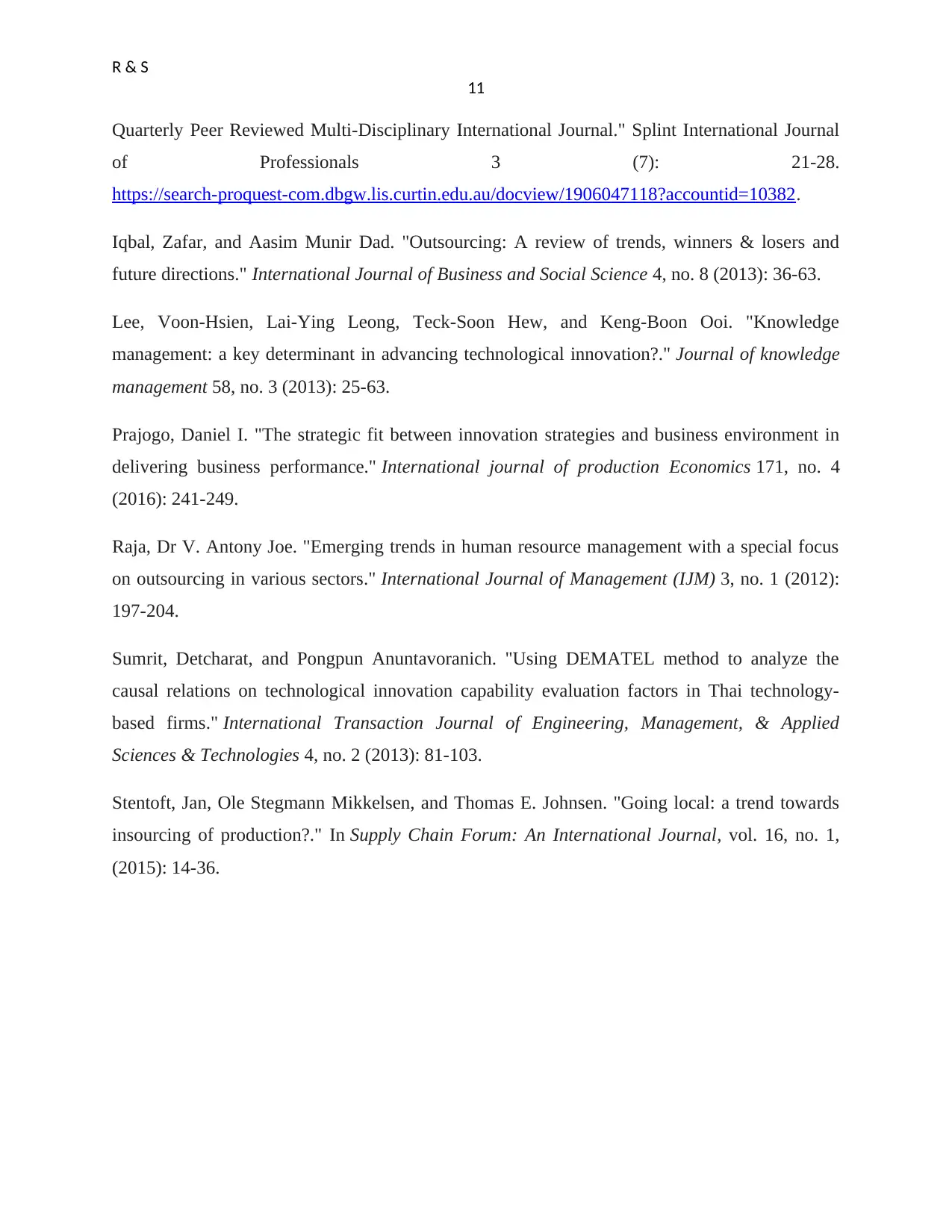
R & S
11
Quarterly Peer Reviewed Multi-Disciplinary International Journal." Splint International Journal
of Professionals 3 (7): 21-28.
https://search-proquest-com.dbgw.lis.curtin.edu.au/docview/1906047118?accountid=10382.
Iqbal, Zafar, and Aasim Munir Dad. "Outsourcing: A review of trends, winners & losers and
future directions." International Journal of Business and Social Science 4, no. 8 (2013): 36-63.
Lee, Voon-Hsien, Lai-Ying Leong, Teck-Soon Hew, and Keng-Boon Ooi. "Knowledge
management: a key determinant in advancing technological innovation?." Journal of knowledge
management 58, no. 3 (2013): 25-63.
Prajogo, Daniel I. "The strategic fit between innovation strategies and business environment in
delivering business performance." International journal of production Economics 171, no. 4
(2016): 241-249.
Raja, Dr V. Antony Joe. "Emerging trends in human resource management with a special focus
on outsourcing in various sectors." International Journal of Management (IJM) 3, no. 1 (2012):
197-204.
Sumrit, Detcharat, and Pongpun Anuntavoranich. "Using DEMATEL method to analyze the
causal relations on technological innovation capability evaluation factors in Thai technology-
based firms." International Transaction Journal of Engineering, Management, & Applied
Sciences & Technologies 4, no. 2 (2013): 81-103.
Stentoft, Jan, Ole Stegmann Mikkelsen, and Thomas E. Johnsen. "Going local: a trend towards
insourcing of production?." In Supply Chain Forum: An International Journal, vol. 16, no. 1,
(2015): 14-36.
11
Quarterly Peer Reviewed Multi-Disciplinary International Journal." Splint International Journal
of Professionals 3 (7): 21-28.
https://search-proquest-com.dbgw.lis.curtin.edu.au/docview/1906047118?accountid=10382.
Iqbal, Zafar, and Aasim Munir Dad. "Outsourcing: A review of trends, winners & losers and
future directions." International Journal of Business and Social Science 4, no. 8 (2013): 36-63.
Lee, Voon-Hsien, Lai-Ying Leong, Teck-Soon Hew, and Keng-Boon Ooi. "Knowledge
management: a key determinant in advancing technological innovation?." Journal of knowledge
management 58, no. 3 (2013): 25-63.
Prajogo, Daniel I. "The strategic fit between innovation strategies and business environment in
delivering business performance." International journal of production Economics 171, no. 4
(2016): 241-249.
Raja, Dr V. Antony Joe. "Emerging trends in human resource management with a special focus
on outsourcing in various sectors." International Journal of Management (IJM) 3, no. 1 (2012):
197-204.
Sumrit, Detcharat, and Pongpun Anuntavoranich. "Using DEMATEL method to analyze the
causal relations on technological innovation capability evaluation factors in Thai technology-
based firms." International Transaction Journal of Engineering, Management, & Applied
Sciences & Technologies 4, no. 2 (2013): 81-103.
Stentoft, Jan, Ole Stegmann Mikkelsen, and Thomas E. Johnsen. "Going local: a trend towards
insourcing of production?." In Supply Chain Forum: An International Journal, vol. 16, no. 1,
(2015): 14-36.
1 out of 12
Related Documents
Your All-in-One AI-Powered Toolkit for Academic Success.
+13062052269
info@desklib.com
Available 24*7 on WhatsApp / Email
![[object Object]](/_next/static/media/star-bottom.7253800d.svg)
Unlock your academic potential
© 2024 | Zucol Services PVT LTD | All rights reserved.





